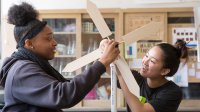Climate Justice Projects Combine Science and Citizenship
Schools and districts can help students make connections between course content, environmental issues, and public policy.
Your content has been saved!
Go to My Saved Content.As another Earth Day approaches, many teachers have been leveraging the opportunity for lessons and projects about climate change. But teaching students about climate change without challenging them to work on solutions is a missed opportunity, including academically.
Pairing teaching of content with putting environmental solutions into action requires students to understand how to analyze issues, gather data, construct effective arguments, and even influence policy decisions.
Faiza Alam, a science and math teacher in Fairfax, Virginia, believes that environmental action projects prompt kids to ask what they can do to make a difference. “They won’t remember worksheets, but they do remember learning by doing,” she says.
Schools and districts that are leading the way with climate projects are ensuring that such memorable learning experiences reach all students.
What One School Can Do
Alam and her colleagues at Lanier Middle School use their campus as the focus for watershed projects that engage students in making scientific observations and designing solutions. Since 2010, students have remediated parking lot runoff, installed rain gardens, helped redevelop an unused courtyard as an outdoor classroom, and collaborated with city and nonprofit partners on a wide range of environmental projects.
Lanier students frequently present their proposals to the school board, state politicians, and expert judging panels. Some efforts result in funding to put proposals into action. After students researched the impact of plastic waste, for example, they proposed installing filling stations for reusable water bottles.
An organization called Earth Force, which combines environmental education with civic skill building, awarded funding to install six stations. “Students then went to the school board and asked for funding for three more filling stations,” Alam says. They presented data to make a convincing argument.
The schoolwide focus on environmental projects started with small steps, says Alam, but with support from school and district leaders, her passion for environmental action, along with her students’ enthusiasm, has spread across content areas.
At Lanier, environmental projects typically begin with science but become the focus of language arts class when students move into proposal writing. Social studies teachers use watershed projects to introduce the history of the Chesapeake Bay. Some projects also integrate the arts. The outdoor classroom has become a focus of visual art projects, and public events often feature music performances that celebrate nature. Environmental projects extend beyond school hours, too: An active Eco Club gives students the opportunity to continue working on environmental service projects outside of class, such as advocating for solar panels on school rooftops.
The school has been recognized for its schoolwide efforts with a Green Flag award from the Eco-Schools USA Program of the National Wildlife Federation.
“It’s all connected. This has become our culture,” says Alam.
A Districtwide Climate Justice Curriculum Takes Shape
While Lanier Middle School offers a compelling example of what one school can do to infuse environmental action across the curriculum, Portland Public Schools in Oregon is taking a districtwide approach. Its pioneering climate justice program sits at the intersection of social justice and environmental action.
“We’ve always had individual teachers with a passion for teaching about climate issues,” says Camille Idedevbo, interim strategy and innovation manager for the district. “Now it’s a priority from K to 12 so that every student gets this.”
A Climate Justice elective that combines science with social studies is currently offered in six Portland high schools. Students tackle projects that they design, often in collaboration with community partners. For example, a student-produced podcast series, launched during remote learning, explored the climate crisis from the perspective of Black and Indigenous people in the community.
Along with the elective, the entire K–12 curriculum is being redesigned to connect climate goals with content standards in both science and social studies. Teachers, students, and community partners are working together on the curriculum overhaul, with completion expected by spring 2022.
“This is how we make this kind of learning not a passion project but a foundation of who we are and what we’re doing as a district,” says Idedevbo.
As the district moves ahead with its ambitious efforts, key strategies are emerging.
Keeping students at the center: A youth advisory team on climate justice elevates student voice on everything from facilities management to curriculum design.
Empowering teachers: Teachers opt in (and are compensated) to work on projects like designing the Climate Justice elective. Professional learning opportunities enable them to share strategies and develop teaching practices in collaboration with colleagues.
Building community relationships: Outreach to potential partners and allies in the community needs to be ongoing, with roles and expectations clearly defined. “You can’t approach this work in a bubble,” Idedevbo says.
A shared vision is another factor that is helping Portland make progress. The district conducted extensive community outreach in 2018–19 to develop a document called Portland Public Schools Reimagined, which includes a "Graduate Portrait." The vision, Idedevbo says, is for students to finish their K–12 experience as change agents.
“They can speak with depth and nuance. They can jump in on designing solutions. And they have a critical lens on the role that equity and social justice play in all this. Climate justice fits beautifully within that vision,” she adds.
Resources
A variety of resources and programs can help you design climate action projects, such as the following:
- Caring for Our Watersheds
- Eco-Schools USA, a project of the National Wildlife Federation
- Education for a Sustainable Future: Benchmarks for Individual and Social Learning
- Project Citizen
- World’s Largest Lesson: Designing for Climate Action
